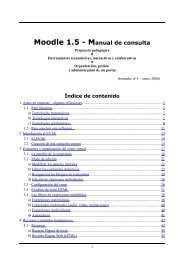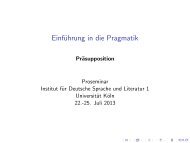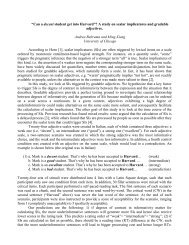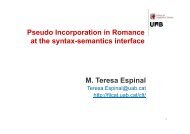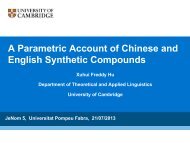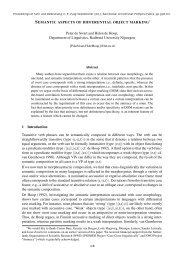Locating adpositions. - corpora@parles.upf
Locating adpositions. - corpora@parles.upf
Locating adpositions. - corpora@parles.upf
You also want an ePaper? Increase the reach of your titles
YUMPU automatically turns print PDFs into web optimized ePapers that Google loves.
18<br />
Veronika Hegeds<br />
This analysis was an early proposal for adpositional phrases being analyzed in terms of<br />
functional projections on top of the lexical PP. Since then, much work has been devoted to<br />
giving a fine-grained analysis for the structure of spatial PPs based on data from various<br />
languages. Analyses of PPs following this line of thought distinguish between separate<br />
projections for at least Location/Place and Direction/Path, like Svenonius (2004) or Van<br />
Riemsdijk & Huijbregts (to appear), but sometimes a range of additional functional structure<br />
is proposed, like in Koopman (2000) or Den Dikken (2003).<br />
3. Hungarian postpositions 1<br />
Hungarian has postpositional elements, and many of them have spatial meanings. Besides<br />
postpositions, oblique case suffixes are also used to express spatial relations. Diachronically,<br />
most of the postpositions and oblique case suffixes originated in possessive constructions,<br />
where the possessum developed into a postposition, and then some of the postpositions lost<br />
their morphological independence and became suffixes (Kiss & Pusztai 2003). This change is<br />
illustrated in (6): in the first stage, the possessum is a case-marked nominal, which later<br />
develops into a postposition. At the stage when it becomes a postposition, the original case<br />
marking is no longer transparent, but the postposition itself has a spatial meaning. In the final<br />
stage, the postposition becomes a suffixal element, its form is phonetically reduced (it is<br />
mostly monosyllabic) and it also participates in vowel harmony.<br />
(6) ház bele-n > ház ben > ház-ban<br />
house inside-at house in house-INE<br />
‘at (the) inside of (the) house’ >> ‘in (the) house’<br />
An important property of these spatial elements is that they often have three related forms<br />
corresponding to locative (‘at’), lative (‘to’) and ablative (‘from’) meanings. This goes back<br />
to their nominal origin, when the nouns were bearing locative case markers expressing these<br />
relations. The three forms are illustrated in (7) where the first one of each pair contains a<br />
postposition and the second a case suffix. 2<br />
(7) a. a ház mellett a.’ a ház-ban<br />
the house beside.at the house-INE<br />
‘beside the house’<br />
‘in the house’<br />
b. a ház mellé b.’ a ház - ba<br />
the house beside.to’ the house-ILL<br />
‘(to) beside the house’<br />
‘into the house’<br />
c. a ház melll c.’ a ház - ból<br />
the house beside.from the house-ELA<br />
‘from beside the house’<br />
‘out of the house’<br />
1 The abbreviations used in the examples are the following: ACC = accusative; ADE = adessive (‘at’); ALL =<br />
allative (‘to’); DAT = dative; ELA = elative (‘out of’); ILL = illative (‘into’); INE = inessive (‘in’); INSTR =<br />
instrumental (‘with’); SUB = sublative (‘onto’); and SUP = superessive case (‘on’); PRT stands for particle.<br />
2 In those examples where the distinction seems important, I will gloss postpositions in a way that it indicates<br />
which one of the three forms they are, but it is important to note that they are synchronically no longer<br />
decomposable into the nominal stem and locative suffix that these glosses suggest.




